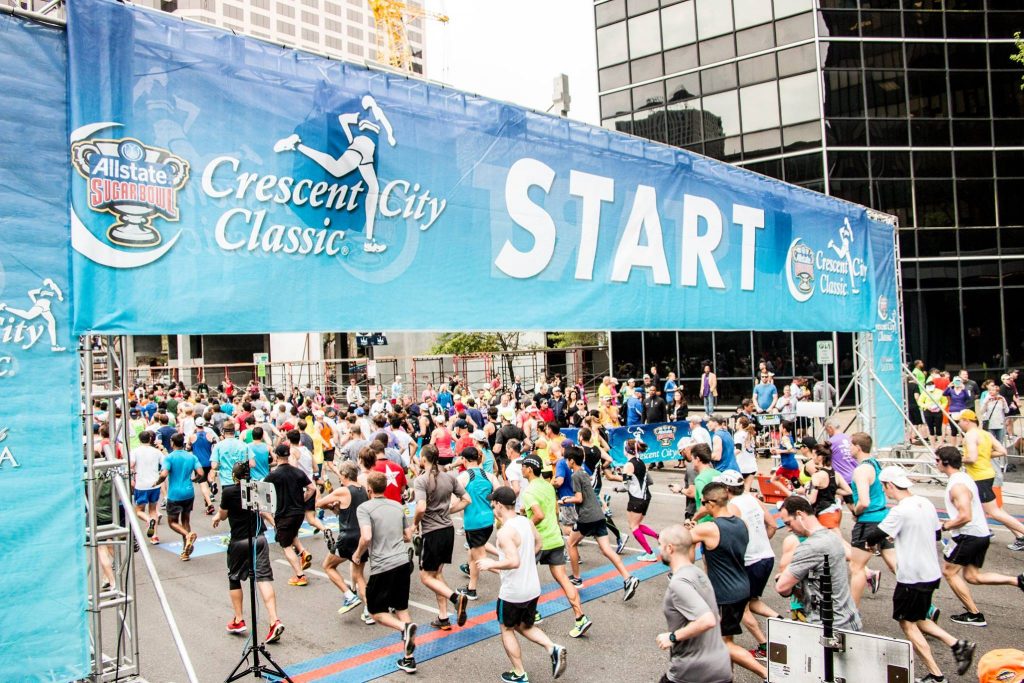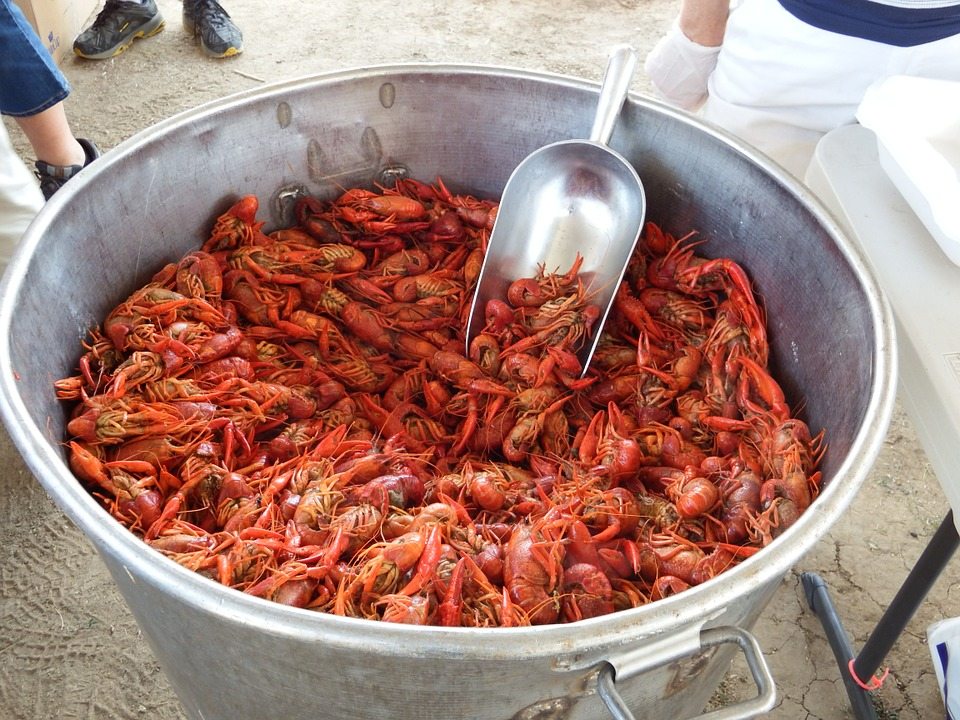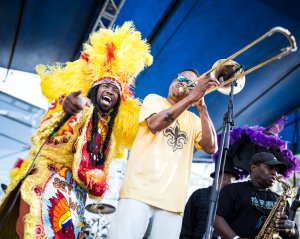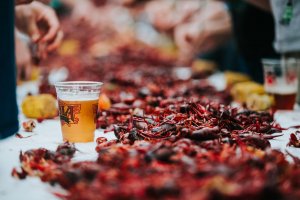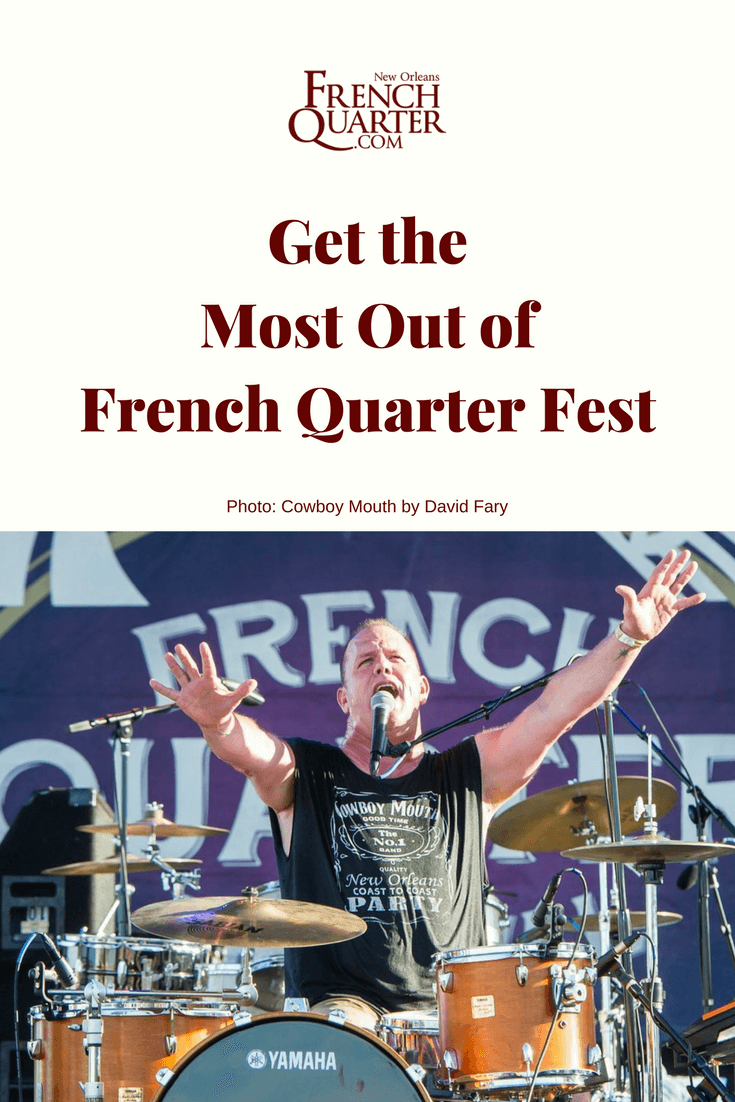Things to Do in New Orleans This April
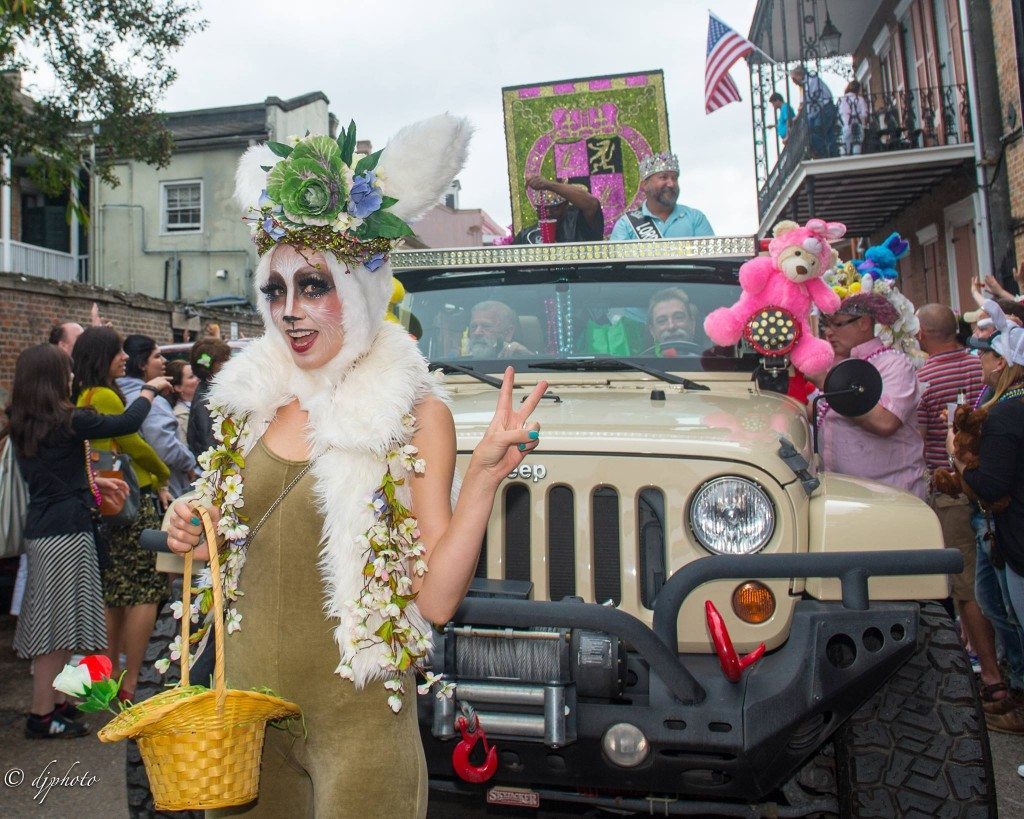
Photo by David Fary
April is one of our favorite months in New Orleans. Between the usually warm winters and super-hot summers, April sits in the New Orleans climatic sweet spot. It’s sunny and you can wear shorts on most days, but it’s not impossibly hot yet. Come evening, when the thermometer starts to dip into the 70s, the air feels something like perfect.
Then there are the festivals, of course. In New Orleans, April is considered the start of the festival season, which lasts from now into the dog days of summer. On almost every weekend (and during the mid-week as well), you’ll find outdoor concerts, parties, live performances, and general revelry just dripping out of the city.
Plus, spring just brings out the love in people. Folks get down, hang out, and are just that much more at ease. In a city nicknamed the Big Easy (you’ll never catch us using that term, but we accept it is a title New Orleans must live with), that’s saying something.
Oh, there’s one other great thing about April: crawfish. Sure, they’re usually in season by March, but April is when the boils really start becoming a common sight citywide.
Here’s how we do April.
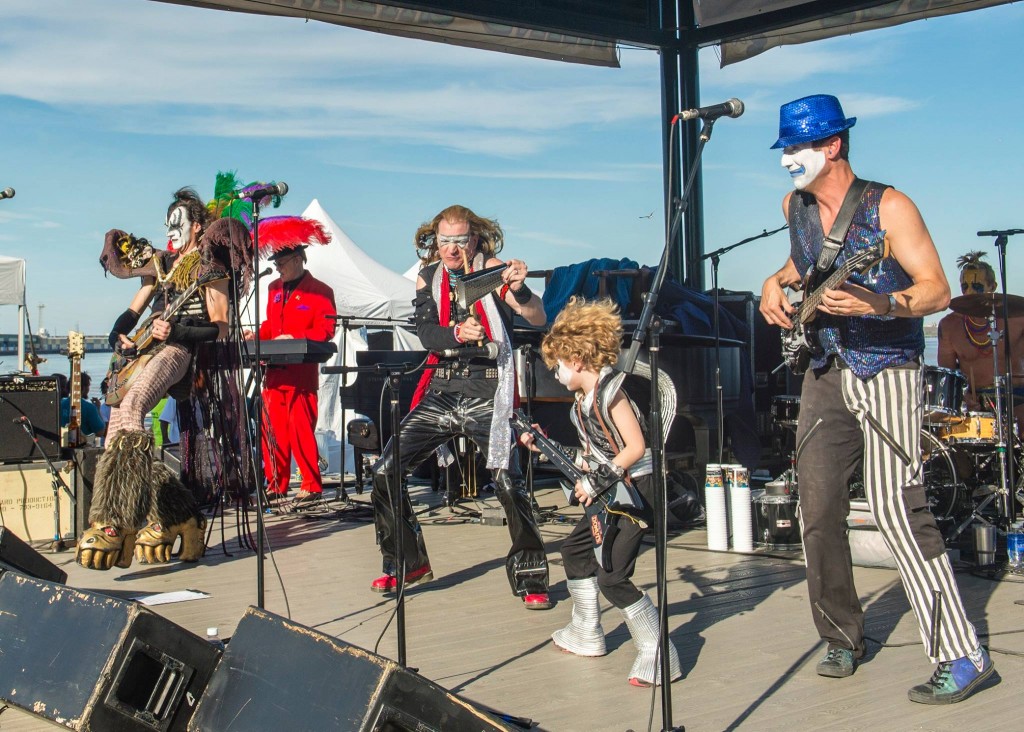
Bag of Donuts by David Fary
French Quarter Fest
French Quarter Festival is the largest free musical event in the New Orleans calendar, and according to organizers, the largest free music festival in the USA. For many, it has become a less crowded, less expensive alternative to the Jazz & Heritage Festival.
With that said, it’s not really fair to describe French Quarter Fest in relation to Jazz Fest. French Quarter Fest stands strongly on its own merits, rocking the city with a fantastic lineup of musicians and an unbeatable setting.
That setting is, as you may have guessed from the name, the French Quarter itself. Unlike so many music festivals around the world, French Quarter Fest eschews a huge grassy space for city streets. And in this case, said streets run through one of the world’s architectural preservation treasures. The festival goes off during the second weekend of April (April 10-13, 2025), which tends to come with gorgeous weather.
Despite featuring about 20 stages and a staggering amount of acts and food vendors, the fest is fairly easy to navigate. Here’s our guide to how to get the most out of the French Quarter Festival if you feel overwhelmed.
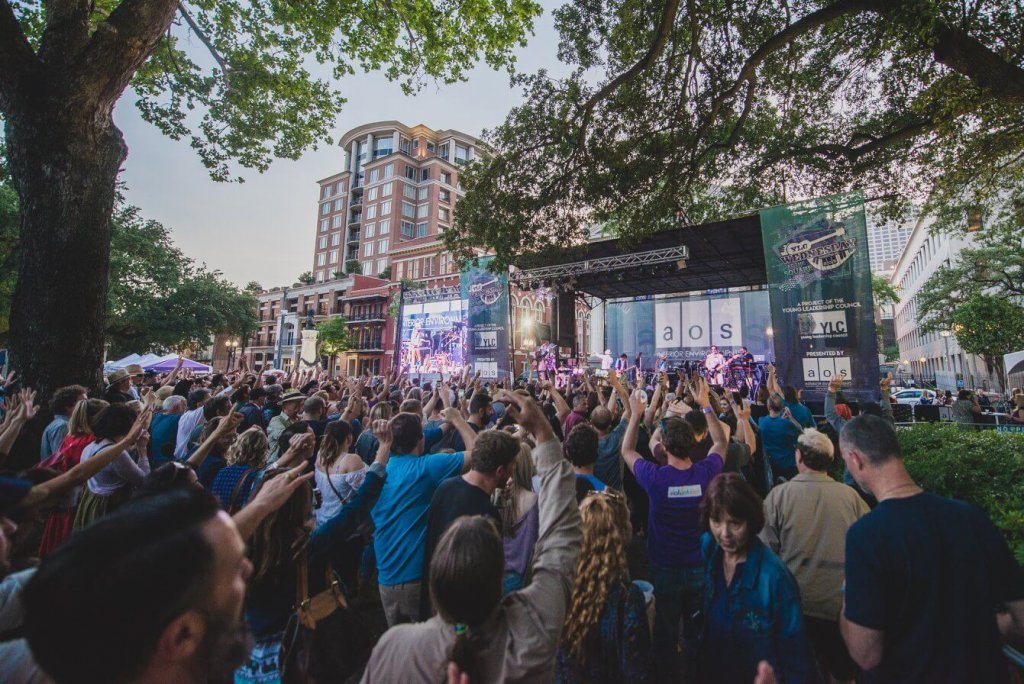
Photo courtesy of YLC Wednesday at the Square on Facebook
Wednesday at the Square
Free music? Good weather? Food stalls? Good folks? All this and more at Wednesday at the Square in downtown New Orleans, which continues for 10 weeks from March 19 through May 7, 2025. The concert series kicks off in Lafayette Square; music lasts from 5 to 8 p.m.
Photo courtesy of Crescent City Classic on Facebook
Crescent City Classic
This annual 10K run is one of the largest athletic events in New Orleans, partly because the race is open to all, and as a result tends to attract a wide swathe of runners, from casual beginners to world-class runners (many don a costume to run, this being New Orleans). You do have to register to run; the cost is $70 (less if you register before April 17, 2025).
Crescent City Classic is also notable for its route, which takes in some of the best cityscapes New Orleans has to offer. Runners take off from downtown in front of the Superdome, run through the French Quarter and the Tremé, then up Esplanade Avenue — one of the most beautiful streets in the nation — all the way to City Park.
If you’re around on the day of the run (Saturday, April 19, 2025), you’ll likely see crowds lining the route, but try not to drive anywhere near the running path, as roads will be blocked off.
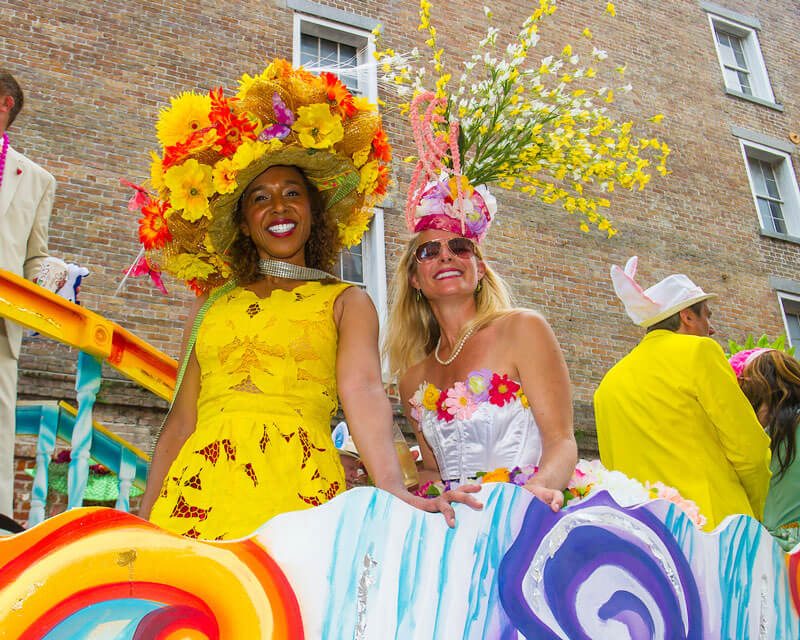
Photo by David Fary
Easter Parades
New Orleans is one of the most Catholic cities in the country, and it celebrates Easter in a big way, although that celebration isn’t always as traditional as one might guess. Long story short: When the 40-day Lent period of fasting ends, New Orleans says, “OK, that was enough self-denial” and throws three big parades. Why? Because New Orleans.
Starting at 11 a.m. on Easter Sunday (Sunday, April 20, 2025) with a hat contest and entertainment at the Omni Royal Orleans Hotel Ballroom, the French Quarter Easter Parade winds its way from there and back starting at 1 p.m. via classic convertible cars and mule-drawn carriages.
The the Chris Owens French Quarter Easter Parade is celebrating its 40th anniversary this year and will have a Great Gatsby theme to honor the late, great Chris Owens (she apparently expressed her wish to have this theme three years ago before her passing). Because it is now prohibited to parade on Bourbon Street (due to the terrorist attack on New Year’s Eve), the parade route will change and the details are still being ironed out.
The final parade of the day is the Gay Easter Parade, which rolls at 4:30 p.m. This one is also a family-friendly affair, and has been a long-standing tradition of the New Orleans LGBTQ+ community.
The paraders will march with floats and horse-drawn carriages, rolling by many of the French Quarter’s most storied gay businesses. Bring the kids to this one, as the Gay Easter Parade is famous for its generous throws and elaborate costuming.
Crawfest
One of the surest signs of spring in New Orleans is the presence of crawfish on menus and at boils across the city, and one of the surest signs that crawfish are back in season is Crawfest. Held on Saturday, April 5 this year, this party, sponsored by Tulane University, features some 20,000 pounds of crawfish, thousands of pounds of vegetables, two main stages, a bunch of bands, and a heavy student presence. This year, Rattlesnake Milk, Quarters of Change, Cardinal Bloom, Pocket Chocolate, Olivia Barnes, and Lost Bayou Ramblers are part of the lineup.
With that said, all are welcome — it costs $20 to get in, and kids 12 and under enter for free. (The fest is also free to Tulane students, with a wristband.) Crawfest kicks off on Tulane’s campus in Uptown, New Orleans.
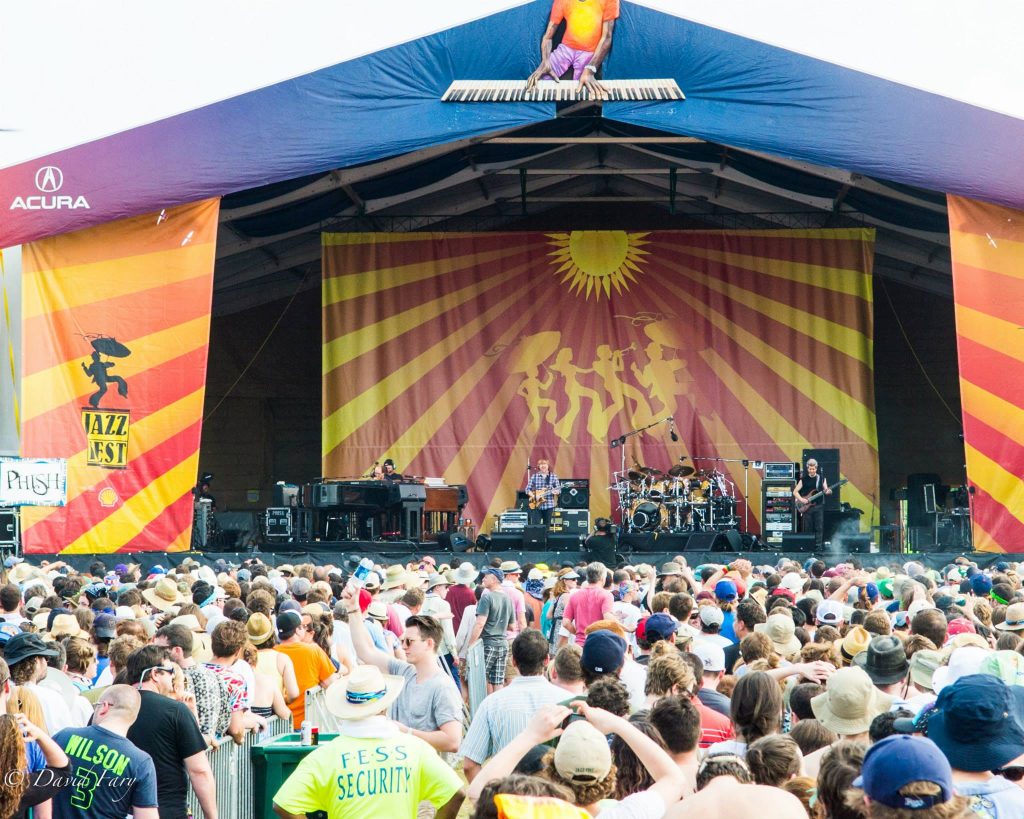
Photo by David Fary
Jazz Fest
The biggest music festival in the best music city in the USA is one of the marquee events of the New Orleans calendar. For the last weekend in April and the first weekend in May (April 24 – May 4, 2025), the city hosts hundreds of bands and thousands of tourists, who stream into the Fair Grounds Race Course from around the world.
Dozens of food vendors will show off the best of local cuisine, while artisans create and trade Louisiana crafts. On the days between the weekends, some of the world’s great musicians will be partying (and often, playing) all around the city.
The New Orleans Jazz & Heritage Festival is a giant event, and in some ways, all of the bands, shows and sheer entertainment options can feel intimidating. Yet once you find your favorite stage and preferred food vendors, and sit down with a cold drink and the breeze blowing across the Fair Grounds, it can also be very intimate — a means of annually connecting to New Orleans at a deep level that is exacerbated by the warm spring sun of April. For some tips, check out our First-Timer’s Guide to the New Orleans Jazz Fest.
If you’re planning a stay in New Orleans, be sure to check out our resource for French Quarter Hotels.
Related Articles
JOIN THE NEWSLETTER!
Get the Most Out of the French Quarter Fest
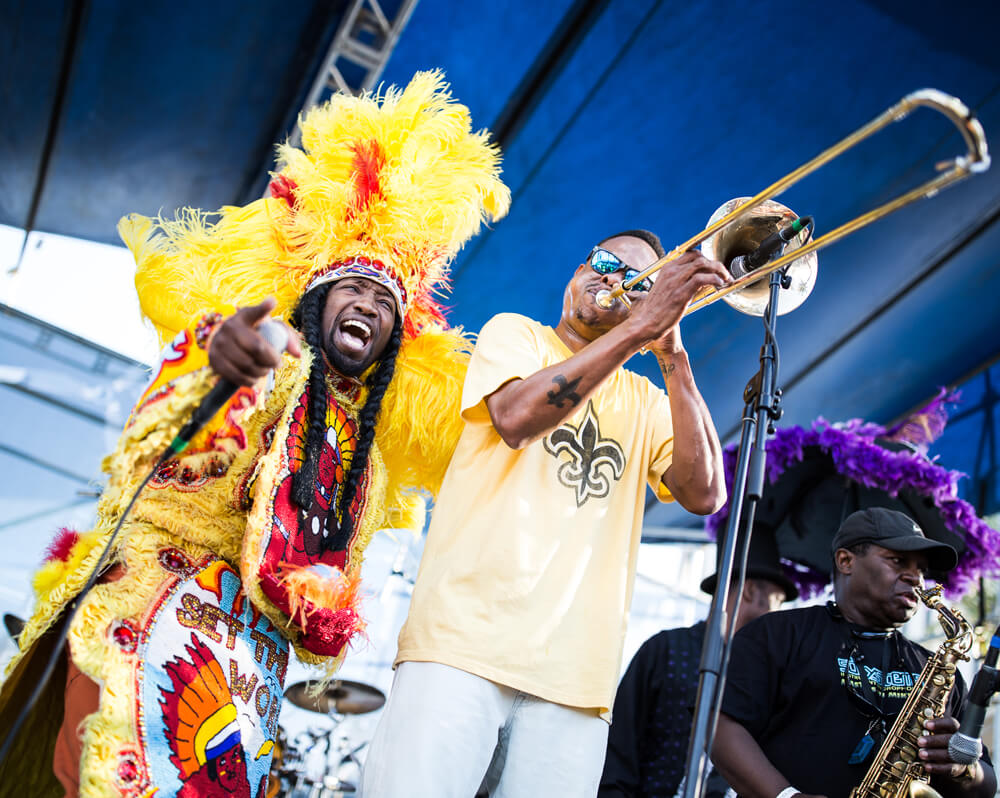
Photo by Zack Smith Photography. Courtesy of French Quarter Festivals, Inc.
French Quarter Fest is back, baby! And it’s its 42nd anniversary, no less. For four days (Thursday, April 10 through Sunday, April 13, 2025), a big chunk of the French Quarter — also known as the Vieux Carré, French for the “old square” (or “old quarter”) — will be transformed into a series of festival stages, each showcasing a different brand of music either rooted in or heavily influenced by, the sounds of Louisiana. Here’s a quick look at what you need to know about French Quarter Fest 2025.
Stage & Music Lineup Highlights
Since 2023 welcomed more than 875,000 fans over four days, this year again expect the total of 22 stages with over 300 performances scheduled. You can find the lineup by stage and, at the same time, by day on the event’s website. The performers are too numerous to mention, but the highlights are the best of what the city and the state have to offer, many of whom have performed at the festival before. There are, of course, artists from elsewhere, and a few newcomers.
We are excited about the music lineup every year, and this year is not exception. Come see Bruce Daigrepont Cajun Band, Corey Ledet Zydeco & Black Magic, BeauSoleil featuring Michael Doucet, Kermit Ruffins & the Barbecue Swingers, The Dirty Dozen Brass Band, Bag of Donuts, Panorama Jazz Band, Anders Osborne, The Soul Rebels, Mardi Gras Indians, and a whole lot of brass, zydeco, blues, and much more.
In other words, the who-is-who of the local music scene is returning or joining this year. Expect beyond excellence when it comes to the French Quarter Fest music lineup.
Food Vendor Highlights
As in the previous year, expect a mouthwatering melting pot of traditional New Orleans dishes such as fried shrimp or catfish, stuffed crabs, locally brewed beers, meat pies, crawfish macaroni and cheese, and hot sausage po-boys. Beyond that, there will be plenty of global flavors.
There will be about 70 culinary vendors on site. Our favorite vendors that are returning include Jacques-Imo’s Cafe, Tujague’s Restaurant, Plum Street Snoballs, 14 Parishes Jamaican Restaurant, Pat O-Brien’s, Miss Linda the Yakamein Lady, Desire Oyster Bar, Morrow’s, Loretta’s Authentic Pralines, Addis NOLA, Cochon King BBQ, and many more.
This year, Chubbies Famous Fried Chicken will have its culinary debut at the festival. (See the full culinary lineup here.)
In addition, Mike’s Amazing Culinary Stage, located in Woldenberg Riverfront Park on the Kohlmeyer Lawn, will feature one-on-one interviews with iconic local chefs and culinary favorites, including Fritai NOLA, Southerns, 14 Parishes, Baroness, Smoke N Honey, and more. Hosted by renowned Chef Kevin Belton, the program will also feature Mike’s Amazing’s own Chef Eleazar Fuerte who will share signature recipes.
Special Events
Every year, the festival features special events. Here are the 2025 highlights.
The French Quarter Festival Kickoff Parade and Opening Day Ceremony
The annual parade is held this year on Thursday, April 10, at 10 a.m. The parade departs from the 200 block of Bourbon Street down to St. Ann Street, where it turns and makes its way to Jackson Square for the Annual Opening Day Ceremony.
Dance Classes
The French Market Traditional Jazz Stage and the Chevron Cajun-Zydeco Showcase will feature dancing and classes in traditional Jazz, 1920s Charleston, swing, Cajun jitterbug, and zydeco. Classes are taught by professional dancers and are free and open to the public. Check out the lesson schedule on the festival’s website.
Children’s STEM Zone
On Saturday and Sunday, families are invited to take a journey of discovery at the Chevron STEM Boat: A Voyage of Discovery.
French Quarter Fest After Dark
The festival offers nighttime programming at various local venues from 9 p.m. till midnight to keep the good times rolling after the last festival stage closes at 8 p.m.
Getting Around the Fest
Getting around the Fest should be fairly easy if you’re walking or biking. Parking will be limited, so arrive early and try these lots: French Market, 500 Decatur Street, 300 North Peters Street, 211 Conti Street, The Garage at Canal Place, plus street parking within walking distance.
We do suggest that instead of driving, you use RTA buses, streetcars, rideshare services bikes, cabs, or the ferry to get to the festival. In addition to increased traffic, some streets will be closed for the duration of the festival beginning at approximately noon until 8:30 p.m. (Those who live in the area will need to have access passes from the NOPD Eighth District Station.) The streets that will be closing are Iberville, N. Rampart, Dumaine, and Decatur.
A Few Facts About French Quarter Fest
Here are a few facts about the fest and what to expect this year:
- The Fest celebrates local music and represents every genre from traditional and contemporary jazz to R&B, New Orleans funk, brass bands, folk, gospel, Latin, Zydeco, classical, cabaret, and international. It’s a medley, and a great way to sample the local music scene.
- It debuted in 1984 as a way to bring residents back to the Quarter following the World’s Fair and extensive sidewalk repairs in the French Quarter.
- The Fest employs more than 1,800 local musicians, with over 60 local restaurants participating as culinary vendors.
- The food and beverage vendors are set up in several locations throughout the French Quarter: Jackson Square, the Jazz Museum at the Mint, JAX Brewery, and Woldenberg Riverfront Park.
- You can buy the official 2025 poster at one of the merch booths at the festival, as well as online.
- To streamline your music experience and navigation, you can download an app on the fest’s website (either for IOS or Android).
- The live-music hours every day of the festival are 11 a.m. to 8 p.m.
- No coolers and ice chests, please. Help keep the festival free by purchasing food and beverages at the festival.
- The festival is cashless. All booths accept major credit cards and digital payments. Need cash exchange? Visit Jax Lot (500 Decatur St.).
- And yes, the fest is free unless you opt to buy a pass for a VIP experience.
If you’re planning a stay in New Orleans, be sure to check out our resource for French Quarter Hotels.
Related Articles
JOIN THE NEWSLETTER!
Nola Crawfish Fest
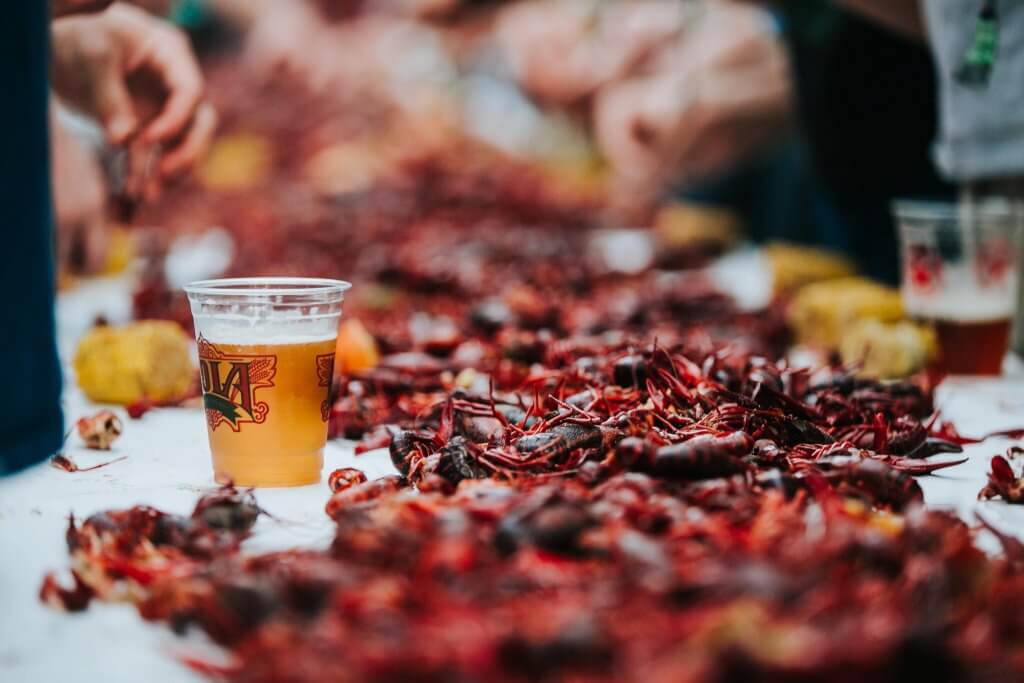
Photo courtesy of NOLA Crawfish Festival on Facebook
Taking place between the two Jazz Fest weekends, the 10th annual NOLA Crawfish Fest features three days of live music, beer, and some 6,000 pounds of boiled crawfish conjured by the NOLA Crawfish King himself, Chris “Shaggy” Davis. The fest will take place at The Broadside (600 N. Broad St.) starting on Monday, April 28, through Wednesday, April 30, 2025 (3-10 p.m.)
The timing might seem unusual, as most New Orleans festivals take place over the weekend, but with all the Jazz Fest fans in town looking to celebrate local culture between the two Jazz Fest-filled weekends this in fact seems perfect.
The venue is a child-friendly indoor/outdoor event space located in Mid-City. As for the music lineup, NOLA Crawfish Fest focuses on featuring local musicians, so this is a great chance to see them jam outside of the Fair Grounds and in a much smaller, more intimate setting.
What Else Do You Need to Know?
The NOLA Crawfish Fest tickets are available for each day and in three-day VIP packages. General admission per day is $64.95. VIP packages start at $130.95. (There’s an option to buy them online on the event’s website). Children under 12 are admitted for free, ages 13-17 can enter with a discounted ticket if it’s paired with a regularly purchased ticket.
There will be other kinds of food besides crawfish available for purchase, like BBQ, as well as drinks. The organizers ask that you don’t bring festival chairs as there’s plenty of seating around the stage and in the food area. This is a rain or shine event. There will be no refunds provided.
In terms of getting there and parking, Jazz Fest is always a very busy time in New Orleans, so expect traffic but a rideshare or a cab are both good transportation options. So is biking, and there is bike parking at the venue. If you plan to drive to the fest, street parking is limited. If you are up for it, The Broadside isn’t that far from the Fair Grounds (two miles), so walking is another option.
We hope you enjoy this chance to celebrate the Louisiana crawfish season!
Are you planning to spend some time in New Orleans soon? To stay close to all the action, book a historic boutique hotel in the French Quarter at FrenchQuarter.com/hotels today!
Related Articles
JOIN THE NEWSLETTER!
A First-Timer’s Guide to the New Orleans Jazz Fest
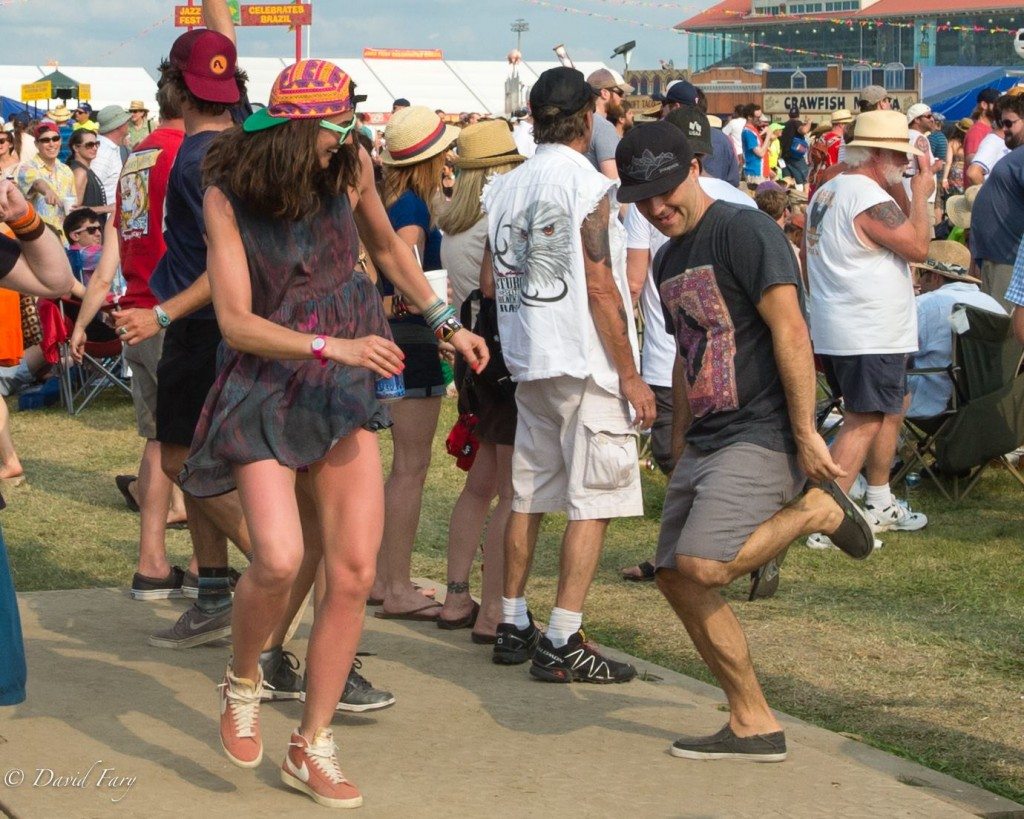
New Orleans Jazz Fest Photo by David Fary
There are many jazz festivals the whole world over, yet there is only one of the genre in the city that birthed it: the New Orleans Jazz & Heritage Festival, which has been around for over five decades and still takes over the city during the last weekend in April, the first weekend in May, and pretty much all days in between (Thursday, April 24 – Sunday, May 4, 2025).
It is fair to say Mardi Gras and Jazz Fest are the two keystone entries of the New Orleans events calendar. Where Mardi Gras is a celebration with deep Catholic and pagan roots that is indelibly branded by the city of New Orleans, Jazz Fest is rather a celebration of New Orleans itself.
That’s the backstory on the “& Heritage” part of the description in the official Jazz Fest title: The event has become less about showcasing jazz per se, and more about showing off the city that gave us jazz.
Because New Orleans is so central to pop music, almost any act and genre you can imagine has strutted on Jazz Fest’s 14 stages — and yes, there are that many stages popping off at the Fair Grounds Race Course & Slots (1751 Gentilly Blvd.) during the 2025 Jazz Fest. As a result of this sheer scope and size, in many ways, Jazz Fest feels like too overwhelming of an event to properly tackle, especially for those who are attending for the first time.
Regarding the festival’s musical acts, there are plenty of commentators who think festival organizers have unfairly stretched the definition of what music falls under the jazz and heritage rubric. We’re not here to debate that topic, but rather point out that there is undoubtedly a wide variety of genre presence at Jazz Fest, which only adds to the looming sense of choice overload.
With all of that in mind, there are some sound tactics for making Jazz Fest more manageable. Here are some of our time-tested strategies.
Ride a Bike
While this choice isn’t going to work for everyone — some visitors simply don’t have urban cycling experience or are scared of the prospect — we can’t stress just how much biking can improve the Jazz Fest experience. Even the most diehard Jazz Fest boosters will admit parking can be a nightmare during the festival. Parking enforcement officers are on high alert — we’ve never seen the impound lot on Claiborne Avenue get quite so busy as it does during Jazz Fest.
Of course, you can pay for parking. Folks who live near the Fairgrounds will turn even the smallest plot of the backyard into an impromptu parking lot (rates vary, but around $30 per day seemed to be the going rate in the past).
There are other ways of outflanking the parking issue, including the official Jazz Fest Express shuttle, taxis (both cars and bicycle rickshaws), rideshare, and the streetcar. Note that if you take the streetcar, you’ll still have to walk about a half mile to the festival entrance. (Take the number 48 line that runs on Canal Street and get off at the final stop at City Park/Art Museum.)
But we really love getting to Jazz Fest on two non-motorized wheels. Bike lane infrastructure can now bring riders to the gates of Jazz Fest. If you’re staying in the French Quarter, the bike ride to the Fairgrounds covers a 10-15 minute straight shot up Esplanade Avenue.
Plus, there is extensive bicycle “parking” (overlooked by security staff) on site. While we can’t guarantee what the weather will be like during Jazz Fest weekends, in general, late April and early May form a lovely climate window in New Orleans.
In addition, being on a bicycle gives visitors a better sense of the city. You can see New Orleans at the street level without the loss of time walking might engender. There’s an intimacy to biking in the city that’s tough to replicate from a car.
Shape Your Cube
The Jazz Fest lineup is famously scheduled into “cubes” for attendees. Devising a schedule for seeing all of your favorite acts can be a fun logistical challenge, but don’t forget that the stages of Jazz Fest are spread out over a decently large area. If you’re in the middle of the crowd at one of the main stages, it can take about 10 or 15 minutes just to extricate yourself from the center of mass.
Note that Sundays and Thursdays always feel a little bit less crowded at the racetrack, although that “little bit less” is admittedly a relative number — there are no real “light” days at Jazz Fest.
The way you assemble your cube is up to you, but here are some pointers we’ve picked up on over the years:
- Stick to your cube, but don’t do so religiously. Part of the fun of Jazz Fest is simply letting the music take you wherever it wants to go.
- Don’t ignore smaller stages. We found one of our great unexpected Jazz Fest shows at the Kids Tent. We also always find the Fais Do-Do stage to be a consistently good break in our routine — basically, you can never go wrong dancing to Cajun or zydeco music.
- Visit the Gospel Tent at least once. We’ve consistently found that even those who know next to nothing about gospel music have their spirits lifted and their musical boundaries expanded in this venue.
Cool Off
It can get hot in Jazz Fest. A few good means of beating the heat include:
- Enjoying the air conditioning in the Grandstands
- Hitting the mist tents by the Gentilly Stage and #2 food vendor area
- Sitting down and relaxing in the vicinity of the Louisiana Folklife Village
- Getting strawberry lemonade and Mango Freeze! (And of course, hydrating with water)
- Staying out of the scrum for bigger headliners
Priorities, Priorities
While the price of Jazz Fest tickets continues to climb, the fact of the matter is you can still see some grade-A headliners for a bargain rate compared to similar (or even smaller) festivals. Many locals treat Jazz Fest as a chance to see big acts on the relative cheap. On the flip side, if you live in or near the city, you can see the New Orleans musicians throughout the year at local venues, which means there’s less pressure to see them on the Fairgrounds.
If you’re coming in from out of town, you may have the opposite scenario prioritized — you can see big-name acts anywhere, but this is your best chance of seeing Louisiana music on its native soil. In addition, smaller local acts often occupy stages that are less crowded, and everyone enjoys a break from the seething masses.
With all of that said, don’t forget that during the “off days” in between the two festival weekends, many smaller and mid-sized acts will be playing gigs around town. If you miss them at the Fest, you may catch them on Frenchmen Street.
With that said, there’s something about seeing local acts at Jazz Fest. The big-name headliners are used to huge audiences. A local Louisiana act would be playing to wow the world, and some of those sets end up being nothing short of legendary.
What to Know About the 2025 Jazz Fest
- Jazz Fest expanded to eight days last year, adding the opening day of Thursday to the schedule. It’s keeping it this year as well.
- Jazz Fest went cashless two years ago, and remains so. Ticket, food, beverage, craft, and merchandise booths no longer accept cash payments. If you come to the event with only cash, the Festival will offer two cash exchange booths near key vending locations so you can get a prepaid card for your cash.
- Like last year, this year, Jazz Fest features over 5,000 musicians across 14 stages.
- Since last year, the festival remains the largest one in its history (it was established in 1970). Eight is the most number of days for the event, and this year expect 60 vendors, offering over 200 different food items.
- Single-day tickets are $89 in advance (through April 8) and $105 at the gate on both Thursdays, and $119 and $135, respectively, on weekends. Tickets for children ages 2-10 are $5 at the gate.
- “Locals Thursday” will be April 24 or May 1 this year (you can pick one day only), with tickets at $50 in advance and $60 at the gate for Louisiana residents. There are also discounted options for local residents for multiple-day passes and single-day entry beyond Thursdays.
- Last year Jazz Fest introduced a 4-day GA+ weekend pass with access to an exclusive GA+ lounge with private restrooms, a full-service bar, and a shaded area to relax. The package is $679 for either weekend this year.
- Headliners include Pearl Jam, Lil Wayne with The Roots, Dave Matthews Band, Lenny Kravitz, Luke Combs, My Morning Jacket, Kacey Musgraves, plus hundreds more artists.
- This year, Jazz Fest will celebrate Mexico’s musical and cultural diversity at the Expedia Cultural Exchange Pavilion. Mexico’s own Santana, chart-topping Banda MS, and Grammy winner Lila Downs headline Jazz Fest’s tribute to Mexico, joined by 19 bands from Mexico — from mariachi to marimba — and more.
- The Jazz & Heritage Gala kicks off Jazz Fest with the celebration of Louisiana music and cuisine on Wednesday, April 23, 2025, at Generations Hall (310 Andrew Higgins Blvd.).
Coming to Jazz Fest This Year?
See the 2024 Jazz Fest music lineup and food offerings on the event’s website. And be sure to check out our resource for French Quarter Hotels!
Related Articles
JOIN THE NEWSLETTER!
Things to Do in New Orleans: Year at a Glance
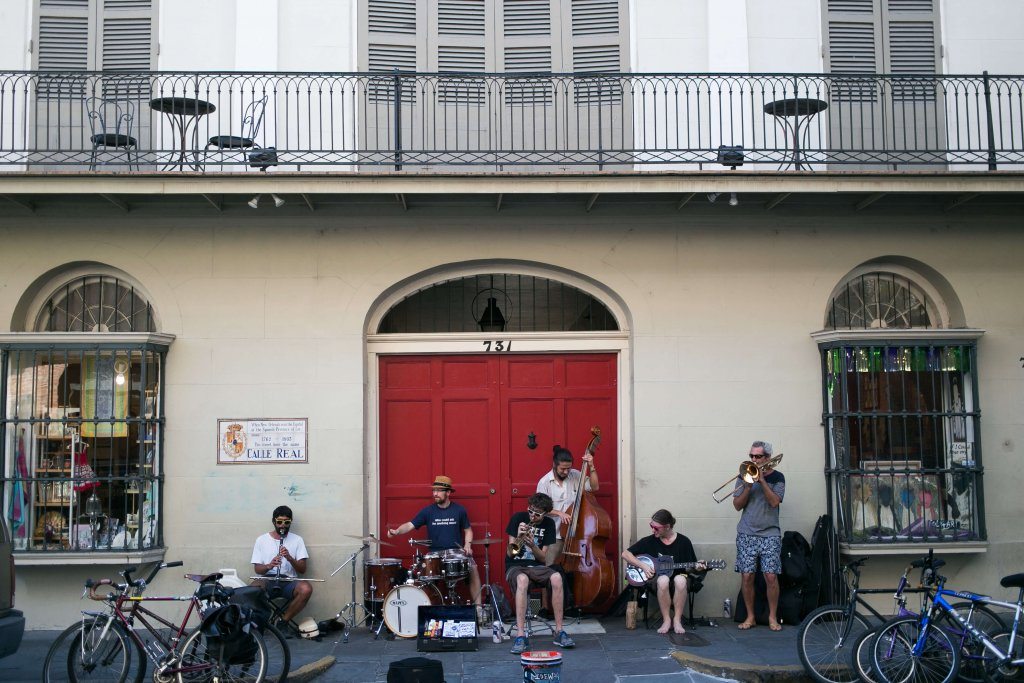
Here’s a medley of annual events to look forward to throughout the year when you’re in New Orleans. Find a hotel and start making plans!
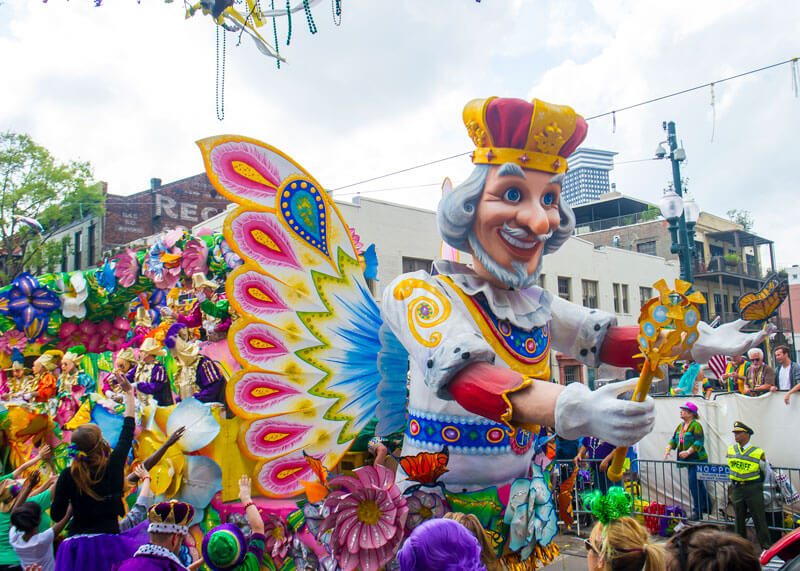
Photo by David Fary
January – March
Twelfth Night
Carnival season officially begins each year on January 6, known as Twelfth Night, or the Epiphany, and kicks off with three parades. Phunny Phorty Phellows board the St. Charles streetcar line Uptown at 7 p.m. and ride it to Canal Street and back, with toasts and revelry along the way.
In the French Quarter, the Krewe of Joan of Arc walking parade rolls at 7 p.m. from JAX Brewery and celebrates St. Joan’s birthday with medieval pageantry. Société Des Champs Elysée, Twelfth Night’s newest parade, traditionally rides the N. Rampart/St. Claude streetcar from Marigny to the CBD.
Mardi Gras
Though Mardi Gras (“Fat Tuesday”) always falls on, well, a Tuesday, the actual date of Mardi Gras Day changes every year. That’s because the beginning of Lent on Ash Wednesday is tied to the Catholic calendar, which itself incorporated elements of earlier, pre-Christian systems. Long story short: Fat Tuesday occurs exactly 47 days before Easter Sunday, which always falls on the first Sunday after the first full moon after the spring equinox.
Confused? Look up future Mardi Gras dates here. You’ll see Mardi Gras always falls in February and March, specifically between February 3 through March 9. So if you visit during that window, you might arrive in time to catch one of the great spectacles of American folk culture.
We could write a whole trove of separate articles on how to do Mardi Gras – heck, we already did! Check here to get started.
Tet Fest
New Orleans is home to one of the largest Vietnamese diaspora communities in the country. In Vietnamese culture, the Lunar New Year – Tết Nguyên Đán – is the largest festival of the year. The date of Tet celebrations is based on the lunar calendar, which differs from the contemporary Western calendar.
In New Orleans, the Mary Queen of Vietnam church in New Orleans East hosts an enormous public Tet celebration that includes games, lots of firecrackers, traditional dance, and a ridiculous amount of excellent Vietnamese street food.
Valentine’s Day
Of course, Valentine’s Day isn’t unique to New Orleans, but the restaurants and general vibe of the city make for a uniquely romantic atmosphere. There are plenty of cozy spots to dine with a sweetie in New Orleans and in the French Quarter in particular.
Wednesday at the Square
Nothing bumps us over the midweek doldrums of hump day quite like a free music concert, which is exactly what’s on tap with Wednesday at the Square. Beginning on a second Wednesday in March, hundreds of revelers will pack into Lafayette Square to enjoy a free outdoor concert series sponsored by the Young Leadership Council of New Orleans.
The 10-concert music series runs through May, so if you miss one, there’s always the next week. Each concert usually features two performers, who start playing at 5 p.m. and wrap up at 8 p.m.
Wednesday at the Square is pet-friendly, as long as your furry friend is on a leash, but no outside food or beverages are allowed. All food and drink are sold via ticketed concessions, which keep Wednesday at the Square free. Concert-goers can also buy cool local art and handmade crafts from on-site vendors.
St. Patrick’s Day
It often comes as a surprise to first-time visitors to New Orleans that this city has a deep Irish heritage. This history is tied to the city’s status as a Catholic port of call, which was one of the main entry points for immigrants coming to the USA.
Because of this heritage, St. Patrick’s Day is an important holiday in New Orleans, both on the holiday itself and the weekends closest to that day. Several parades roll, including the Downtown Irish Club procession from the Ninth Ward to the Quarter.
The king of ‘em all is the Irish Channel Parade, where tipsy Irishmen clad in kilts trade paper carnations for kisses in between floats full of riders tossing beads and passing cabbages to the screaming crowds. For details and this year’s dates, check New Orleans St. Patrick’s Day Parades.
Super Sunday
On select days throughout the year, the city’s Mardi Gras Indian tribes parade through the city, chanting, shouting and challenging each other to determine who is “the prettiest.” While Mardi Gras Indians have their set routes and parade areas, no one event packs the tribes into one public space like Super Sunday.
On Sunday closest to St. Joseph’s Day (March 19), tribes gather at A.L. Davis Park, at the corner of Washington and LaSalle streets, and hit the streets of Central City around 1 p.m.
We can’t stress this enough: Be respectful if you go. Take pictures at a distance, and don’t get in the way of marching Indians or their friends, family and attached bands.
For visitors not familiar with this tradition: Mardi Gras Indians are African American New Orleanians who dress up (or in local lingo, “mask”) as stylized Native Americans. They take to the streets in fantastic costumes made of hand-stitched beads, feathers and sequins that cost thousands of dollars, weigh hundreds of pounds and require months of painstaking labor; no element of costume creation is automated.
There’s more background on this fascinating subject at the Backstreet Cultural Museum in the historic Tremé neighborhood.
Tennessee Williams Literary Festival
The Tennessee Williams Literary Festival (March 26-30, 2025) celebrates the city’s love affair with the written word, as well as writers’ love affair with New Orleans. Notable authors will be in attendance, hosting seminars, workshops and lectures. Though only paid registrants can attend those events, anyone can participate in the annual “Stella” and “Stanley” shouting contest, and scream their lungs out recreating the iconic scene from A Streetcar Named Desire to appreciative crowds on Jackson Square.
April – May
These months sit in the sweet spot of New Orleans weather. It’s sunny and you can wear shorts on most days, but it’s (usually) not super hot yet. Come evening, when the thermometer starts to dip into the 70s, the air feels something like perfect.
Crescent City Classic
This annual 10K run is one of the largest athletic events in New Orleans. Held on the Saturday before Easter Sunday each year, this year’s race falls on Saturday, April 19, 2025.
Partly because it is open to all, the Classic attracts a wide swathe of runners, from casual beginners to world-class pros. (Everyone must register to run).
The race is also notable for its route, which winds through some of the best cityscapes New Orleans has to offer. Runners take off from in front of the Superdome, continue through the French Quarter and the Tremé, then up Esplanade Avenue – one of the most beautiful streets in the nation – all the way to City Park.
French Quarter Fest
French Quarter Festival is the largest free musical event on the New Orleans calendar, and according to organizers, the largest free music festival in the USA. As its name suggests, the entire festival takes place on stages throughout the French Quarter, where the streets run through one of the world’s great treasures of architectural preservation. This year’s FQF is scheduled for April 10-13, 2025, which tends to come with gorgeous weather. For more details, check out our guide to how to get the most out of French Quarter Festival.
Easter Parades
New Orleans is one of the most Catholic cities in the country, and it celebrates Easter in a big way, although that celebration isn’t always as traditional as one might guess. Long story short: When the 40-day Lent period of fasting ends, New Orleans says, “OK, that was enough self-denial,” and throws three big parades, which roll this year on Sunday, April 20, 2025.
Jazz Fest
The biggest music festival in the best music city in the USA, the New Orleans Jazz & Heritage Festival is one of the marquee events on the annual calendar. Every year, on the last weekend in April and the first weekend in May, the city hosts hundreds of bands and thousands of tourists, who stream into the Fairgrounds from around the world.
Dozens of food vendors serve up the best of local cuisine, while artisans create and sell Louisiana crafts. On the days between the two festival weekends, some of the world’s great musicians will be partying (and often, playing) at gigs all around the city.
Jazz Fest is a giant event, but once you find your favorite stage and the preferred food vendor, and sit down with a cold drink and the breeze blowing across the Fairgrounds, it can also be very intimate – a means of annually connecting to New Orleans at a deep level. Be sure to pack a hat, sunscreen and rain gear, because that warm spring sunshine can get mighty hot, and it’s a rare Jazz Fest that isn’t muddied by at least one shower.
This year’s festival opens on Thursday, April 24, and runs through Sunday, May 4, 2025.
Bayou Boogaloo
The Bayou Boogaloo (May 16-18, 2025) has become as much a fixture on the festival calendar as its Mid-City neighbor, Jazz Fest, and the city’s street-party season opener, French Quarter Fest. What started as a gathering of a few hundred festival diehards has grown into a massive event that attracts tens of thousands of guests.
Bayou Boogaloo is no longer free, but its bucolic setting as a floating party, with its flotillas of inflatables, paddle boats and kayaks, gives the three-day festival its own unique character, while its stellar lineup of local and visiting musical artists rivals those offered by its much-bigger older siblings. So does its ever-growing menu of fest-worthy food and drink.
June – August
Summer in New Orleans can be pretty tough to endure, but we’ve got a slate of festivals that will either cool you off, or at least keep your mind off the heat.
New Orleans Wine & Food Experience
The annual New Orleans Wine & Food Experience (June 11-15, 2025) provides local and visiting epicureans and hobbyists an extended weekend of libations and culinary indulgence in a style that is uniquely New Orleans. NOWFE is designed to encourage participation in the full gamut of food and wine-centered experiences. The event offerings include package rates, activities, and dinners with something at nearly every price point with attire ranging from costumed to cocktail depending on the event and venue.
Restaurant Week New Orleans
New Orleans loves to eat – and sometimes, its citizens live to eat. There were, at last count, over 17 James Beard award-winning restaurants in New Orleans, and many tourists and locals like to sample these spots during Restaurant Week New Orleans. Participating restaurants include James Beard luminaries like Bayona and Commander’s Palace, which offer set-course menus at a discount (often, a deep discount). The 2025 dates are June 11-15.
Independence Day
New Orleans celebrates July 4 like anywhere else in America, and also, with a flavor all her own. Of course, there will be fireworks and loud music, but the pretty lights pop off over the Mississippi River. There are plenty of great spots to watch the display, but a good French Quarter balcony is one of the most desired viewing spots in the city. You can also grab excellent vantage points along the Mississippi shoreline in the French Quarter, Marigny and Bywater, or across the river in Algiers Point.
There’s a lot to love about ESSENCE Festival, the largest annual African American music and culture event in the world. It brings a star-studded lineup of musical artists to a city already well-known for its gatherings of world-class musicians.
Beyond the marquee concerts that are held each night, ESSENCE Fest’s free daytime experiences include motivational seminars, beauty and style presentations, celebrity interviews, cooking demonstrations with top chefs, and lots more. Traditionally held over the long 4th of July holiday weekend, ESSENCE Festival is scheduled for July 3-6, 2025.
San Fermin in Nueva Orleans
Plenty of people know that the Running of the Bulls is a major event in the Spanish tourism calendar, but not as many folks realize New Orleans hosts its own bull run. Except here, the “bulls” are roller derby girls who whack the participants – dressed all in white with red scarves and handkerchiefs – with wiffle bats. Good times!
The actual “bull run,” which now features thousands of participants, starts at 6:30 a.m. on Saturday, July 12, 2025. But the folks at NOLA Bulls have a full slate of events lined up throughout the weekend of July 11-13, 2025. Runners must register and buy tickets to participate in the Bull Run, with all proceeds from the event going to charity.
Tales of the Cocktail
Some of the world’s most famous cocktails were invented in this city: the Sazerac, Brandy Milk Punch, and Ramos Gin Fizz, to name a few. Having a drink in New Orleans isn’t just fun – it’s also a celebration of our unique history.
Still, New Orleans can’t just let a cultural touchstone lay without holding a festival: Tales of the Cocktail, a celebration of mixed drinks in all of their vast diversity. With tasting rooms and seminars held throughout the Quarter, Tales draws thousands of bar owners, distillers, mixologists, authors, and tastemakers who are interested in networking, sharing knowledge and showing off their skills. This year’s event runs from July 20-25, 2025.
Coolinary
Coolinary is simple: Dozens of participating restaurants offer prix fixe menus at a discount during the dog days of summer throughout the month of August. Sometimes, a significant discount. Interested? Just check out the Coolinary website and see what restaurants are participating (and for which meals; some spots, for example, only offer a Coolinary menu during lunch). You don’t have to do anything else but show up and get fed.
Satchmo SummerFest
An initiative from the folks at French Quarter Festivals, Satchmo SummerFest is a celebration of the city’s most famous musical son – Louis Armstrong, nicknamed “Satchmo” – and New Orleans music in general. As New Orleans festivals go, this one is pretty beloved; it’s family-friendly, kicks off within the French Quarter, and the lineup is truly local.
More than almost any other festival in this city of festivals, this one feels like a real New Orleans street party, and should definitely not be missed if you’re in town. Held the first weekend of every August, this year’s Satchmo SummerFest runs on August 2-3, 2025.
Fidelity Bank White Linen Night
Back in the days before air conditioning, New Orleanians kept cool and looked fresh in the face of August swelter by wearing light-colored linen clothing. In order to boost gallery attendance and showcase local summer fashion, White Linen Night was created. Held the first Saturday of every August, it’s since become a gala see-and-be-scene party.
This year, art galleries and restaurants in the Warehouse District will throw their doors open for a night of wine, art perusing, dining, and more wine on August 2, 2025. There’s also a free block party between the 300 and 700 blocks of the gallery-heavy Julia Street, with food and cocktail vendors and several stages of live music.
Red Dress Run
Probably the last thing any sane human being wants to do in the midst of a New Orleans August is run. Then again, the folks involved with the New Orleans Hash House Harriers (NOH3) have always been a little crazy; they’re a “drinking club with a running problem.”
Held the second Saturday of August, the Red Dress Run is your chance to see a bunch of locals of all genders don red frocks and go careening through the city on a madcap 2-3 mile course, kept secret until the day of the event. Registration for this year’s event, on August 9, 2025, opens in April, with all proceeds going to local charities.
Dirty Linen Night
The more rebellious sibling to White Linen Night, Dirty Linen is an evening of open galleries, but in this case, the galleries are located in the French Quarter along Royal Street. The vibe is a little looser and more counterculture, especially when Red Dress stragglers hit Dirty Linen to enjoy the wine gallery owners pour freely. Peruse art, grab a bite from food trucks, hit the bars for a cocktail, and enjoy an unbridled celebration of the creativity of the city. Held on the second Saturday of August, this year’s event falls on August 9, 2025.
September – December
Fall and winter bring cooling temperatures and a slate of events closely associated with the New Orleans cultural community.
Southern Decadence
Held over Labor Day weekend, New Orleans’ largest LGBTIQA+ event is a citywide party that celebrates the huge impact the local gay and lesbian community has on the city at large. The party kicks off within the Quarter on Friday, August 29, 2025, and picks up steam throughout the weekend, spreading across New Orleans as more and more guests swoop into town for several days of… well, as the title says, decadence (including block parties and a parade).
Tremé Fall Festival
This is one of our favorite neighborhood parties in a city that knows how to throw a neighborhood party. Held in October (Saturday, October 25, 2025), the event takes over the streets of the oldest African American neighborhood in the country.
Centered around the historic St. Augustine Church, the oldest African-American Catholic church in the United States, the festival celebrates a culture that’s produced some of the city’s most talented musicians, many of whom are among the event’s performers.
The family-friendly festival is free, but suggested donations help raise money for church repairs and historic neighborhood landmarks, like the Tomb of the Unknown Slave.
Halloween
Halloween in New Orleans is sort of like Halloween in your home city but multiplied by a few hundred degrees of awesome. We’re a city that likes to costume and make mischief, and if you’re going to miss Mardi Gras, you can get a taste of the chaos and costuming of that holiday – just head to the French Quarter and the Marigny on the Saturday night before Halloween.
Conveniently, this is also the evening of the Krewe of Boo parade (Saturday, October 25, 2026), which rolls from Marigny into the Decatur end of the Quarter and features a fine lineup of spooky floats and excellent throws.
Oak Street Po-Boy Festival
There is a po-boy for every budget and palate in New Orleans at this annual fest, typically held in the fall between the 8100 and 8800 blocks of Oak Street in the Carrollton neighborhood. About 35 vendors will present more food that you could shake your fork at, while competing in several Best Of categories, with over 50 varieties of the delicious sandwich alone. Plus beer, specialty cocktails, and desserts. (The date for 2025 TBA.)
Tremé Creole Gumbo Festival
The New Orleans Jazz & Heritage Foundation puts on plenty of events in New Orleans, but the Creole Gumbo Festival, combined in recent years with the Congo Square Rhythms Festival, is the perennial favorite. It’s not just a celebration of the city’s great contribution to the genre of stew; it’s a party that commemorates great music and culture – and the place (the Tremé) – that produced the dish. Held at Louis Armstrong Park, this free weekend festival features a stellar lineup of some of the city’s finest musicians. Really, you have no excuse not to attend. (The dates for 2025 TBA.)
LUNA Fête
During the second weekend of November (November 13-16, 2025), the LUNA Fête light show illuminates part of the downtown New Orleans from Gallier Hall to the Piazza d’Italia, located a quick walk away from the Quarter. The annual large-scale light and sound installations are breathtaking, and the fest is free and family-friendly.
Bayou Classic
You might wonder what holiday it really is on Thanksgiving weekend, when the Tigers of Grambling State meet the Jaguars of Southern University for the annual Bayou Classic in New Orleans. Each year, football crashes into the holidays for a four-day feast of events, starting with a massive Thanksgiving parade from the Superdome to the French Market, featuring some of the country’s absolute best marching bands.
Christmas in New Orleans
There’s a whole slew of events that accompany Christmastime in the Crescent City, from bonfires on the Algiers levees to City Park’s Celebration in the Oaks to Reveillon menus at some of the city’s classic Creole restaurants. But surely one of the most pleasurable events to be had during a New Orleans December is simply strolling through the French Quarter, marveling at the inevitably awesome light displays that are hung from wrought iron fences and elegant European-style balconies.
NOLA ChristmasFest
The annual NOLA ChristmasFest is the only indoor Christmas festival in the area. It takes place at the New Orleans Ernest N. Morial Convention Center, on December 20-29, 2025, this year.
Convention Center Boulevard is draped and dripping in holiday decorations with thousands of lights synced to holiday music, and the Convention Center itself is packed with attractions like giant slides, inflatables and rides. The focal point of the festival is New Orleans’ only ice-skating rink, which measures a whopping 52 x 140 feet.
Celebration in the Oaks
This beloved New Orleans tradition has been around for over 30 years. It’s a dazzling display of holiday lights scattered throughout the 25 acres of the City Park, including the Botanical Garden, Storyland, and Carousel Gardens Amusement Park.
Stroll through the magical grounds swathed in hundreds of thousands of twinkling lights, take a train ride or a holiday picture by the iconic Mr. Bingle, listen to the caroling, do some holiday shopping, or ride the historic carousel.
The event typically opens on Thanksgiving weekend and runs through January 1.
New Year’s Eve
From Dick Clark Rockin’ New Year’s Eve near the historic JAX Brewery, featuring a live fleur-de-lis drop at midnight to the countdown on Jackson Square (New Orleans’ version of the Times Square NYE party), it’s no surprise that New Orleans celebrates New Year’s Eve in a big way. Top it off with the fireworks over the Mississippi River and quite a few balcony bashes on Bourbon Street, and you’ve got yourself a night of revelry, New Orleans style.
If you’re planning to visit New Orleans anytime throughout the year, be sure to check out our resource for French Quarter Hotels.
Related Articles
JOIN THE NEWSLETTER!
This May in New Orleans
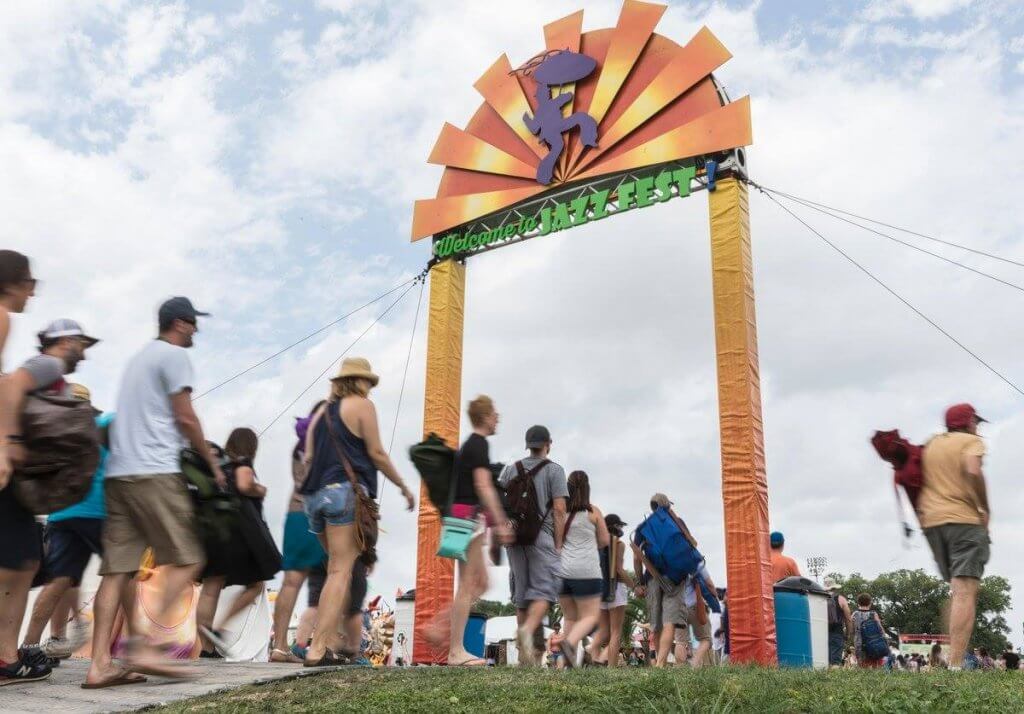
Photo courtesy of New Orleans Jazz & Heritage Festival on Facebook
May sits in the New Orleans climatic sweet spot. It’s sunny and you can wear shorts on most days, but it’s (usually) not super hot yet. Come evening, when the thermometer starts to dip into the 70s, the air feels something like perfect. If you’re planning a trip to New Orleans this May, find your French Quarter hotel, and check out these big events you can enjoy during your stay.
Jazz Fest
Thursday, April 24 – Sunday, May 4, 2025
The biggest music festival in the best music city in the USA is one of the marquee events of the New Orleans calendar. For the last weekend in April and the first weekend in May, the city hosts hundreds of bands and thousands of tourists, who stream into the Fair Grounds Race Course from around the world.
Dozens of food vendors will show off the best of local cuisine, while artisans create and trade Louisiana crafts. On the days between the weekends, some of the world’s great musicians will be partying (and often, playing) at gigs all around the city.
The Jazz Fest lineup is famously scheduled into “cubes” for attendees. So, find your cubes, and enjoy yourself!
Bayou Boogaloo
Friday, May 16 – Sunday, May 18, 2025
The Bayou Boogaloo has become as much a fixture on the festival calendar as its Mid-City neighbor, Jazz Fest, and the city’s street-party season opener, French Quarter Fest. What started as a gathering of a few hundred festival diehards has grown into an event that attracts tens of thousands of guests.
Its bucolic setting as a floating party, with its flotillas of inflatables, paddle boats and kayaks, gives the three-day festival its own unique character, while its stellar lineup of local and visiting musical artists rivals those offered by its much bigger older siblings. So does its ever-growing menu of fest-worthy food and drink.
New Orleans Greek Festival
May 23-25, 2025
New Orleans Greek Festival returns on Memorial Day weekend to the Holy Trinity Greek Orthodox Cathedral (1200 Robert E. Lee Blvd.). As usual, expect great Hellenic music, traditional dancing, cathedral tours, ouzo, Greek wines and Greek coffee, plus, of course, the food. Oh, the food. Souvlaki, baklava, dolma (stuffed grape leaves), spanakopita (spinach pie), and gyro sandwiches (pita bread pockets stuffed with lamb, pork and zesty sauce), and more. The fest is kid-friendly, and is held both indoors and outdoors.
LGBTLOL Queer Comedy Fest
May 29 – June 1, 2025
Kick off Pride Month at the LGBTLOL Queer Comedy Fest. The lineup will feature queer-identifying comedians from around the world. Check the event’s website for details.
More May Events
Although not specific to New Orleans, there are a few events you can celebrate here with gusto. Grab a margarita at one of our many wonderful restaurants on Cinco de Mayo (Monday, May 5, 2025), celebrate Mother’s Day (Sunday, May 11, 2025) by booking brunch at one of the many elegant eateries, or visit The National World War II Museum to honor the Memorial Day (Monday, May 26, 2025).
Coming to New Orleans in May?
Check out our guide to where to stay in the French Quarter, and be sure to check out our resource for French Quarter Hotels. Also, consider booking a guided tour of St. Louis Cemetery No. 1 to experience the hauntingly beautiful past of New Orleans.
For easy, informative sightseeing, we recommend the City Sightseeing New Orleans city tour on the open-top, double-decker bus. It runs every 30 minutes through the Garden District, French Quarter, and CBD. You can hop on and off anytime!
Happy May!
Related Articles
JOIN THE NEWSLETTER!
Mother’s Day in the French Quarter and Nearby

New Orleans and the French Quarter in particular are fantastic options for Mother’s Day (Sunday, May 11, 2025), from the elegant perfection of jazz brunches and the relaxing stroll on the scenic Mississippi Riverfront to exploring the magnificent architecture of the centuries-old streets and shopping in the chic local boutiques. Show your appreciation for the mothers in your life with these suggestions, below. Just please remember to make your reservations in advance as Mother’s Day is a popular time for brunching and dining.
Brunch
Brunch with Mom is one of New Orleans’ most popular Mother’s Day activities. Not only do the French Quarter and the adjacent Marigny and Bywater neighborhoods have some of the best restaurants in the country but several have excellent Mother’s Day special brunch offers. Broussard’s Mother’s Day jazz brunch is usually held in the courtyard and features the restaurant’s classic French Creole cuisine plus bottomless rose or mimosas. (To make a reservation call 504-581-3866 or book online.)
The classic Sunday jazz brunch at either Antoine’s or Arnaud’s is elegance personified and is a perfect way to give back to the women and mothers in your life. Or treat your mom to a happy hour or dinner at The Bombay Club, featuring specialty cocktails and lots of martini options.
The French Quarter has some of the best European-style patisseries in the country, so if you want a classic French croissant or quiche head to Croissant D’Or Patisserie.
Outside the Quarter, if you’re up for a scenic walk or ride through the historic neighborhood of the Marigny, check out Ayu Bakehouse, a bright, quaint corner shop with a mellow vibe. There are savory pastries, crusty baguettes, sweet croissants, cookies, and buns, plus breakfast and lunch items like a frittata and seasonally rotated sandwiches.
Still further down, in the Bywater, you can hit The Country Club’s brunch of gluten-free shrimp and grits or boudin boulettes in the restaurant, or just head to the pool that has its own, poolside menu. There’s also a very popular drag brunch at 10 a.m. and 1 p.m. (it sells out quickly, so a reservation is a must).
Exploring the French Quarter on foot
Few cities in the world have as much easily accessible and well-preserved architecture as New Orleans. If your mom is up for walking, explore the centuries-old streets of the French Quarter and the nearby mostly residential Marigny to take in all the magnificent architectural elements they have to offer, with all their lush tropical courtyards with gurgling fountains, French doors, stucco exteriors, lacy Victorian ironwork, and vibrant Caribbean colors.
While you’re at it, you can stroll the mile-long Riverfront with its walkway called the Moonwalk, the scenic views of the Mississippi River, and Woldenberg Park.
Don’t miss the French Market across the street, from its food stands to the daily flea market at the end of Esplanade Avenue. It’s a great stop to slurp a dozen raw oysters, or pick up pralines and a beignet mix to take home from any of the surrounding retail shops.
Just down the street is one of the most important national landmarks, the timeless Jackson Square with Andrew Jackson’s bronze statue as the focal point of the square, surrounded by lush greenery. Come inside the St. Louis Cathedral that overlooks the square, to take in its stunning interior, or shop at the block-long rows of the Pontalba Buildings that flank the square in both directions.
Jackson Square also features an open-air artist market and performance space, with local art displayed along the fence. While there, browse the art, dance to a brass band, have your fortune told, or have a sketch done on the spot.
Taking a carriage ride
If your mom is not up for walking, unveiling the city’s colorful past is as easy as taking a mule-drawn carriage ride through the streets of the French Quarter. Just grab a first-come-first-serve French Quarter Mule Tour offered by Royal Carriages on Decatur Street right outside the Jackson Square gate, from 8 a.m. through midnight daily. Some tour packages stick to the Quarter only; others venture out to the Marigny or St. Louis Cemetery #1.
Shopping
Besides what the French Market and the shops surrounding Jackson Square have to offer, you can head down to the chic boutiques lining Chartres Street, branching off the square and leading to Canal Street.
One of the most popular destinations on the Chartres Street retail row is Hemline, which carries a well-curated shoe and women’s fashion collection from local and national brands. Also on Chartres, the well-hidden United Apparel Liquidators (UAL) is unsurpassed for hunting name brands with deep discounts (and even some haute couture). And, if you head to Canal Street, there’s a slew of upscale retailers at The Shops at Canal Place, from Saks Fifth Avenue to Tiffany & Co.
Dining
It’s going to be easy to impress your mom with dozens of stunning options in the French Quarter and nearby. You’ll be in good hands at the enchanting Sylvain on Chartres Street, with a candlelit bar and a lovely patio. The charming Bayona also offers a patio, along with a historic setting of a two-century-old Creole cottage on a quiet block of Dauphine Street.
If you want to go with the upscale Creole cuisine in unbeatable locations, then Tujague’s, Napoleon House, or Muriel’s Jackson Square won’t steer you wrong. For something less traditional but still sophisticated head to Cane & Table for a top-notch cocktail and small plates, or hit the hole-in-the-wall Cuban gem, Manolito. Of course, the one and only Galatoire’s needs no introduction (where you’ll be lucky to get a table).
Finally, why not wrap up with a glass of bubbly and the world-famous Bananas Foster in a lush courtyard at Brennan’s, flambeed tableside? Giving back to your mom has never been easier.
Coming to New Orleans this spring?
Check out our guide to where to stay in the French Quarter, and be sure to check out our resource for French Quarter Hotels. Also, consider booking a guided tour of St. Louis Cemetery No. 1 to experience the hauntingly beautiful past of New Orleans.
For easy, informative sightseeing, we recommend the City Sightseeing New Orleans city tour on the open-top, double-decker bus. It runs every 30 minutes through the Garden District, French Quarter, and CBD. You can hop on and off anytime, and your mom won’t have to do all this walking!
Happy Mother’s Day!
Related Articles
JOIN THE NEWSLETTER!
Bayou Boogaloo Returns to Mid-City This May
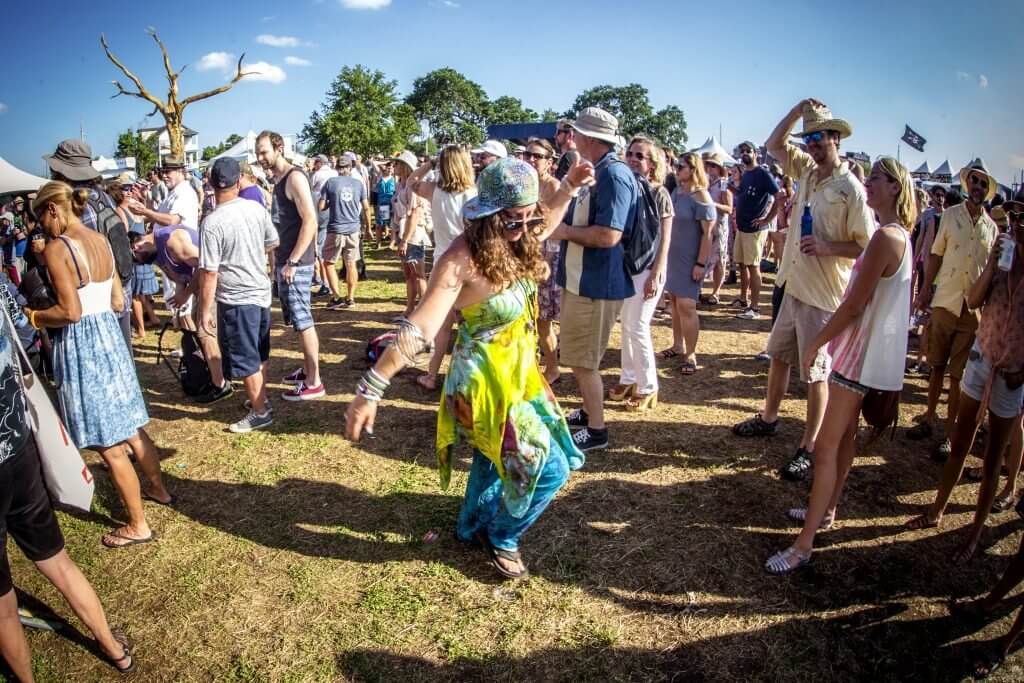
Photo courtesy of Bayou Boogaloo
One of the standouts in the seemingly never-ending string of festivals New Orleans hosts all year round is the Bayou Boogaloo, which grew from the post-Katrina scrappy little neighborhood festival to a weekend-long extravaganza.
Since its inception in 2006, Bayou Boogaloo now draws upwards of 35,000 people and has become as much a fixture on the festival calendar as its Mid-City neighbor, Jazz Fest, and the city’s street-party season opener, French Quarter Fest.
Also a favorite of both the locals and the in-the-know visitors, this festival takes place not in the French Quarter but on the sprawling, picturesque banks of Bayou St. John — between Dumaine Streets and Lafitte Avenue in the Mid-City neighborhood. Its bucolic setting as a floating party, with its flotillas of inflatables, paddle boats, and kayaks, gives the three-day festival its own unique character.
Bayou Boogaloo 2025
This year, Bayou Boogaloo takes place between Friday, May 16, and Sunday, May 18, 2025. Just like in previous years, the festival is kid-friendly. Traditionally, the Boogaloo focused on mostly local music, including the best of the brass bands, zydeco, Mardi Gras Indians, and other incredible New Orleans and Louisiana acts.
This year’s headliners include Big Freedia’s Gospel Revival, Leo Nocentelli and 420 Funk Mob, featuring members of Parliament Funkadelic. A couple of tribute shows feature Alexis Marceaux singing songs by Alanis Morissette and the Honey Island Swamp Band’s Dark Side of the Bayou show featuring music by Pink Floyd.
The lineup also includes LSD Clownsystem, rap collective glbl wrmng, Crowe Boys, Anjelika “Jelly” Joseph, Desert Nudes, Billy Iuso, Bo Dollis Jr. & the Wild Magnolias, and more.
In addition to two stages, the Mid-City Bayou Boogaloo features a curated art market, a Kid’s Cultural Pavilion, a VIP Crescent 9 Canopy Club, a crawfish eating contest, and food from numerous Mid-City and local vendors. The main stage will feature music while the second stage, Variety Stage, will have lots of comedy acts and burlesque.
The food and beverage vendor list is as varied as in previous years and includes Ajun Cajun, Empanola, Bub’s NOLA, Clesi’s, Fritai, T-Swirl Crepe, and more. Look for snowball and lemonade booths, and plenty of booths with adult beverages from neighborhood favorite Pal’s, local breweries, and others.
How Much Does It Cost?
An early bird weekend pass is $24.50 (sold out). Festival-goers don’t have to choose between land and water tickets, it’s $39.50 for a weekend pass either way, with re-entry allowed. As always, kids 12 and under are granted free admission.
Additionally, three-day Crescent 9 Canopy Club VIP passes are available for $229.00. These passes also allow re-entry plus access to the Crescent 9 Canopy Club VIP area, which is a shaded oasis next to the stage with front stage access, an elevated viewing deck, private restrooms with AC, and a selection of complimentary beverages and local eats.
What Else Do You Need to Know?
Street parking in the neighborhood is limited, so biking is encouraged (there’s plenty of bike parking at the fest). Thanks to the city’s added bike routes, including Lafitte Greenway, you can ride your bicycle all the way to the festival from virtually every corner of the city.
Alternatively, you can come by canoe, kayak, or other paddle-friendly vessel. All attendees arriving by water should enter under the Orleans Bridge where the staff will scan their ticket and then be required to go through security. People in boats and rafts are expected to have floatation devices on hand (and wear them if they are under 16) and follow other boating regulations.
Another way to reach the fest is by taking a streetcar. Two lines stop a short walk away from the festival, Canal Streetcar: City Park/Museum, and Cemeteries Canal Street.
Gates open at 4:30 p.m. on Friday and 11 a.m. on Saturday and Sunday.
Chairs are welcome (look out for the “no chair zones” in front of each stage designated for dancing), but no outside food or drink, please. No pets are allowed.
Finally, although you will see some festival attendees splashing happily in the bayou, there are gators, snakes, and sharp debris like car parts and tree branches in the bayou, so swimming is highly discouraged. Plus, there are no lifeguards on duty, and there’s a whole lot of drinking.
To get updates on the music and vendor lists for this year, check out the Bayou Boogaloo website or the festival’s Facebook page.
Are you visiting this spring and planning on attending Bayou Boogaloo? We got you covered! Check out our top recommendations for hotels in the French Quarter.
Related Articles
JOIN THE NEWSLETTER!
June Festivals in New Orleans
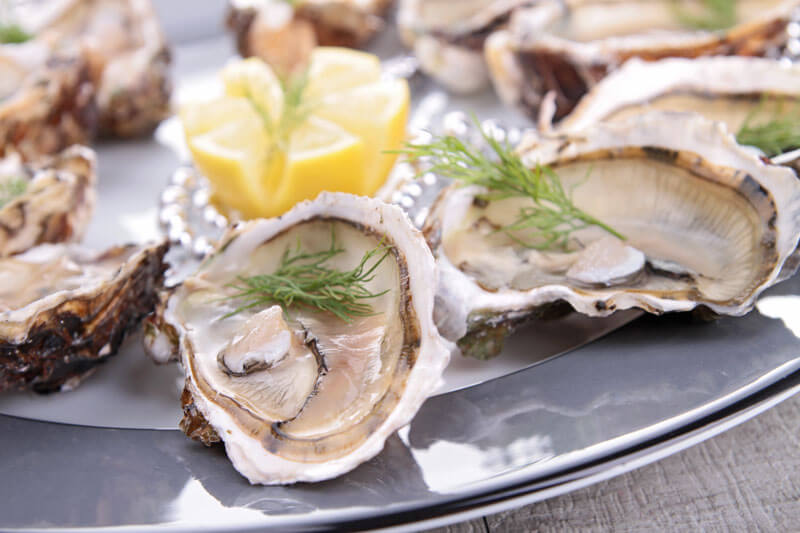
The end of spring and the beginning of summer in the French Quarter is packed with celebrations of local food, music, and culture — going well into August. Here are a few must-attend events happening in June in and near the French Quarter.
French Market Creole Tomato Festival
Saturday-Sunday, June 7-8, 2025
Traditionally held in early June, the annual (and free!) French Market Creole Tomato Festival welcomes the arrival of Creole tomatoes that Louisiana loves to incorporate into many local recipes. The French Market location and the food offerings make this a popular festival among locals and visitors alike.
Celebrating its 39th year in 2025, the festival features live music at the market and in Dutch Alley, kids’ activities, and a second line. There are cooking demos in addition to an extensive menu from participating food vendors of Creole tomatoes incorporated into gelato, crepes, crawfish pies — you name it. You can also get Creole tomatoes from the participating farm stands.
Kick off the Creole Tomato Festival with the Ripe & Ready second line on Saturday, June 7, at 10:30 a.m. It’s open to all, and you’re encouraged to wear “your favorite tomato attire.” The second line will form at Oscar Dunn Park, 700 Decatur Street across from Jackson Square, and walk to the French Market festival location. On both Saturday and Sunday the fest will be held from 11 a.m. to 5 p.m.
The festival is spread out between the tents and the stages located at the Farmers Market, the New Orleans Jazz Museum at the Old U.S. Mint (this one is indoors), and Dutch Alley. The live music schedule never disappoints.
New Orleans Wine & Food Experience
Wednesday-Sunday, June 11-15, 2025
In its 33rd year in 2025, the New Orleans Wine & Food Experience (NOWFE) is a smorgasbord of food and wine tastings, tours, master classes, and the annual champagne-soaked burlesque brunch. Each year, hundreds of wineries and restaurants participate, offering menus featuring local flavors and innovative new creations inspired by diverse cuisines.
Top chefs from around the city create unique culinary experiences, so much so that the event regularly makes a few national “best of” festival lists. The organization behind this popular event is a nonprofit that donates 100% of its proceeds to beneficiaries ranging from food banks to culinary schools. You can see all the events and get tickets online.
New Orleans Pride
Friday-Sunday, June 12-15, 2025
Launched in 2011, New Orleans Pride is a weekend-long celebration taking place in the French Quarter to celebrate and honor LGBTQ+ communities and their allies in New Orleans and surrounding areas. It is the only official Pride Festival in New Orleans, the largest in Louisiana, and one of the fastest-growing Pride celebrations in the nation.
Special events include the Pride Gala, the PrideFest block party at the Phoenix bar, and the annual parade. The parade rolls on Saturday, June 14, 2025, starting at 3 p.m. at the Armstrong Park and rolling through the French Quarter. The parade is family-friendly for all to enjoy.
Restaurant Week New Orleans
Monday-Sunday, June 14-20, 2025
During this time, you can enjoy multi-course, special menus and dining deals in numerous participating restaurants, from upscale Creole eateries to neighborhood bistros. Keep up with this year’s list of participating restaurants and their menus, and don’t miss a chance to try a new spot or revisit your favorite.
Father’s Day
Sunday, June 15, 2025
Though technically it’s not a festival, you can make it your own by honoring your dad! Take your dad to brunch, a museum, or just a walk at the Riverfront. Make your reservation soon, and enjoy the good food and fun this city has to offer!
New Orleans Juneteenth Festival
Thursday, June 19, 2025
Come to Congo Square in Armstrong Park to commemorate this remarkable date with this free festival, held from noon to 6 p.m.
Coming to New Orleans in June?
Check out our guide to where to stay in the French Quarter, and be sure to check out our resource for French Quarter Hotels. Also, consider booking a guided tour of St. Louis Cemetery No. 1 to experience the hauntingly beautiful past of New Orleans.
For easy, informative sightseeing, we recommend the City Sightseeing New Orleans city tour on the open-top, double-decker bus. It runs every 30 minutes through the Garden District, French Quarter, and CBD. You can hop on and off anytime!
Happy June!
Related Articles
JOIN THE NEWSLETTER!
The New Orleans Wine & Food Experience Returns in June
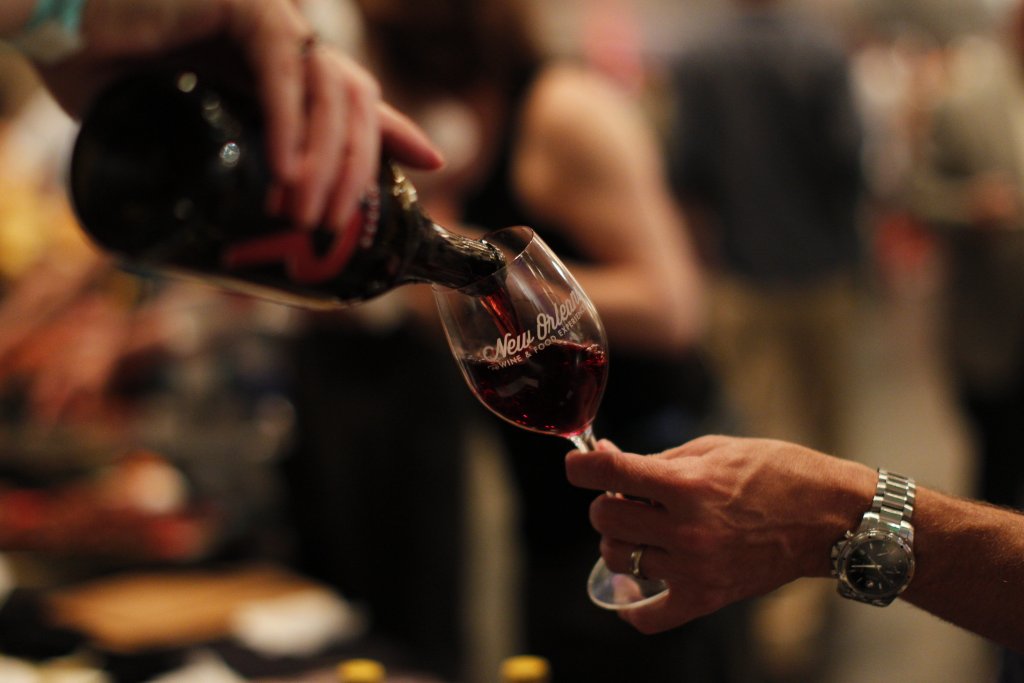
In its 33rd year in 2025, the New Orleans Wine & Food Experience (NOWFE) is a smorgasbord of food and wine tastings, tours, masterclasses, and the annual champagne-soaked burlesque brunch. This year, NOWFE is held on Wednesday, June 11, through Sunday, June 15, 2025.
What Is NOWEFE?
Each year, hundreds of wineries and restaurants participate, offering menus featuring local flavors and innovative new creations inspired by diverse cuisines. Top chefs from around the city create unique culinary experiences, so much so that the event regularly makes a few national “best of” festival lists.
Who Benefits From NOWFE?
The organization behind this popular event is a nonprofit that donates 100% of its proceeds to beneficiaries ranging from food banks to culinary schools. The 2025 beneficiaries are the Louisiana Restaurant Association Education Foundation, Delgado Community College Culinary Arts Program, and FirstLine School’s Edible Schoolyard Program. You can find out more about each on the NOEFE website.
NOWFE Event Highlights
You can see all the events online (and buy tickets while you are it) but here are some musts you should know about if you think of attending NOWFE.
What: Vinola
When: Thursday, June 12, 2025, 5:30-8:30 p.m. VIP, 6-8:30 p.m. general admission
Location: Orpheum Theater, VIP at Double Dealer
This elevated tasting is your chance to sample a variety of rare and highly valued wines expertly paired with foods crafted by local chefs. Winemakers will present elite wines from around the world, while award-winning chefs will be on hand to serve and talk about their food and what inspires them in its creation.
What: Tournament of Rosés
When: Friday, June 13, 2025, 7-9:30 p.m.
Location: Generations Hall
Dress to impress and party New Orleans style at the annual Tournament of Rosés. Taste some premier rosés — both still and sparkling — from France, Spain, Italy, the United States, and South America. Enjoy tasty bites from New Orleans restaurants and tunes from a DJ.
What: The Grand Tasting
When: Saturday, June 14, 2025, 2:30-6:00 p.m. VIP, 3-6:00 p.m. general admission
Location: New Orleans Ernest N. Morial Convention Center, The Great Hall
This tasting showcases wines from around the world and food served by New Orleans chefs. You’ll get a chance to ask the winemakers and the chefs questions, learn about wine and wine pairings, and eat some seriously delicious local food. The attending restaurant list is long and an impressive who-is-who of the New Orleans culinary world.
What: Burlesque, Bubbly & Brunch
When: Sunday, June 15, 2025, 11 a.m. -1 p.m.
Location: The Omni Royal Orleans
Truly a one-of-a-kind experience, Burlesque, Bubbly & Brunch features plated brunch, bottomless sparkling wine, and a burlesque performance by Trixie Minx Productions. The menu is a crowd-pleaser with a local flavor.
Other events include wine dinners, master classes on wine blending and crafting cocktails, parties, and much more.
You can get event tickets a la carte or in three packages (Tasting, The Connoisseur, or the VIP).
Coming to NOWFE?
Check out our guide to where to stay in the French Quarter, and be sure to check out our resource for French Quarter Hotels. Also, consider booking a guided tour of St. Louis Cemetery No. 1 to experience the hauntingly beautiful past of New Orleans.
For easy, informative sightseeing, we recommend the City Sightseeing New Orleans city tour on the open-top, double-decker bus. It runs every 30 minutes through the Garden District, French Quarter, and CBD. You can hop on and off anytime!


